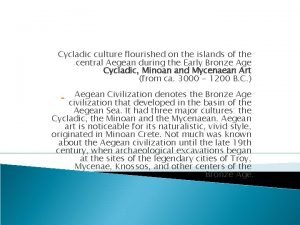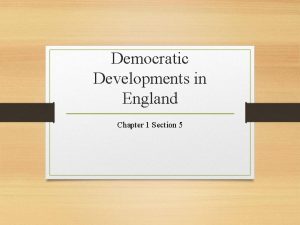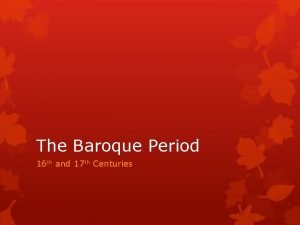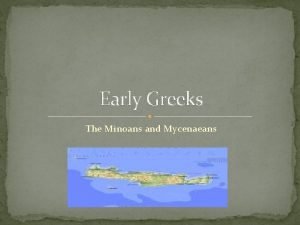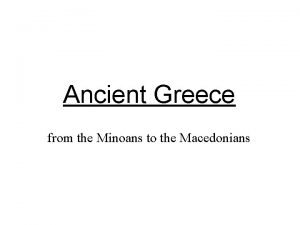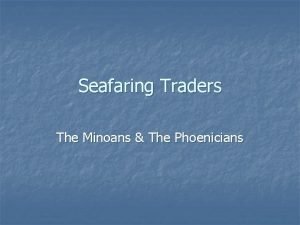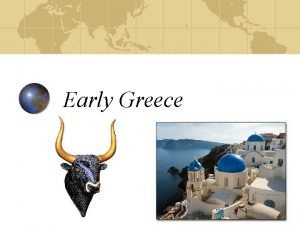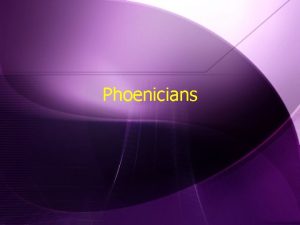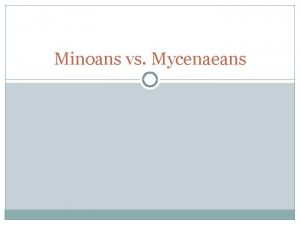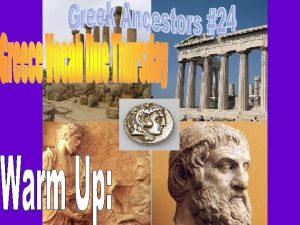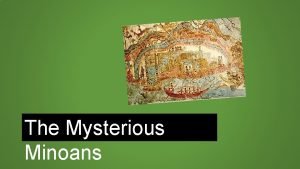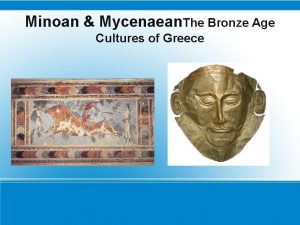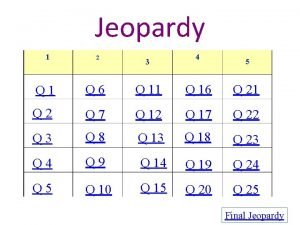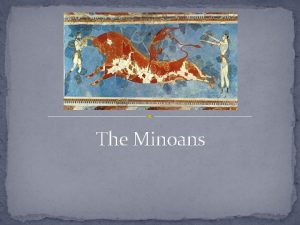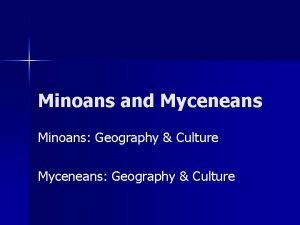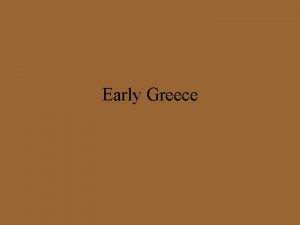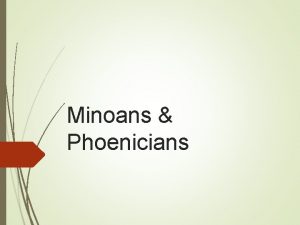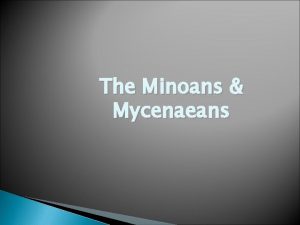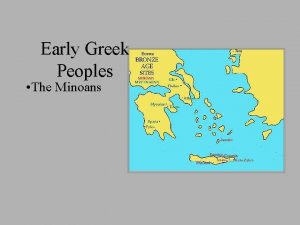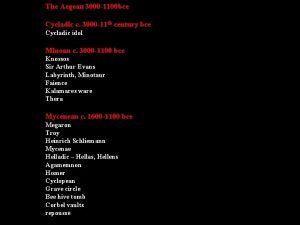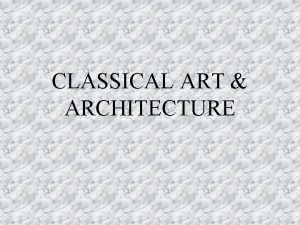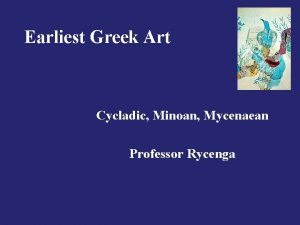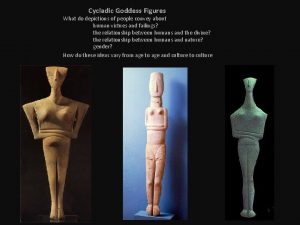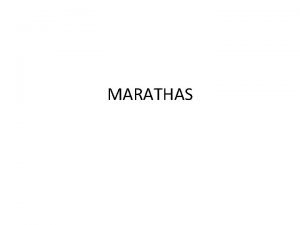The Minoans Who The Minoans emerged from Cycladic






















- Slides: 22

The Minoans

Who? �The Minoans emerged from Cycladic and Pelasgian culture around 2100 BCE �They established dominance over Crete and most of the eastern Mediterranean, including Cyprus �Culture reached its height around 1500 BCE

Minoan Way of Life �Sea-faring population �Economic base = fishing, trade � 2000 BCE: controlled trade in Mediterranean Sea

Minoan Society � Peaceful � Paintings of natural world � Enjoyed music and dancing � No army, no navy � High degree of equality between sexes � Family and royal names passed down through daughter � Worshipped goddesses, not gods � Extreme sports enjoyed by both girls and boys � High standard of living � Bright, airy buildings (natural air conditioning) � Hot/cold water, flush toilets � Apparent over-abundance of food � But… a dark side too � Practiced human sacrifice

Bull Leaping Fresco


The Palace at Knossos

Knossos Palace �Built around 1700 BCE �Running water �Multiple stories �Bathrooms �Elegant gardens �No walls!

Plan of Knossos

Sir Arthur Evans �English aristocrat �Began excavating Knossos in 1905 �Gave the culture its name – Minoan � After mythic King Minos associated with the labyrinth – perhaps a real place at Knossos? ? �Died at Knossos

Evans’ Reconstructions

Found the “oldest throne”

Palace Culture �Several palaces dot the island of Crete �Each palace ruled a district �Each collected raw materials and finished goods as tribute (tax) �Palaces traded goods with each other and with foreign nations, such as Egypt

Minoan Ceramics �Minoan trade based in part on ceramics trade: pots and dishes �Pharaoh Akhenaton traded Egyptian gold for Minoan pottery �Archaeologists call it “eggshell ware” b/c it is so thin

Minoan Writing �Called “Linear A” by archaeologists

Minoan Collapse �Around 1450 BCE, Minoan civilization began to fail �Several theories for decline: � Invasion � Natural disaster � Mythical

Invasion Theory �Mycenaean pirates from mainland Greece invaded Crete �Burned palaces and took over the land

Natural Disaster Theory �Island of Thera (Santorini) erupted around 1500 BCE �Resulting ash cloud and tidal wave buried or swamped Minoan civilization

Eruption Crater �Most of Thera was blown away in the eruption of 1500 BCE �The crater, now filled with sea water, still survives �Thera is still an active volcano

Akrotiri, Thera �Ruins of Akrotiri, on Thera, support the volcano and tidal wave theory �Ruins are clearly Minoan in origin �Eruption buried and destroyed the town

Village of Akrotiri, Thera

Myth of the Minotaur �A young Greek prince, Theseus, was brought to Knossos �He was to be sacrificed to the Minotaur – a huge monster the King kept in the palace labyrinth �The Minotaur had the head of a bull and lived on human flesh �Theseus was put into the labyrinth where he fought the monster with a magical sword and killed it �When the Minotaur died, the power of the Minoans died too
 Cycladic culture
Cycladic culture What is urdu hindi controversy
What is urdu hindi controversy How did parliament emerged victorious in medieval england
How did parliament emerged victorious in medieval england Who emerged as patrons in the baroque period?
Who emerged as patrons in the baroque period? After the mycenaeans defeated the minoans,
After the mycenaeans defeated the minoans, The rulers of the minoans were ________.
The rulers of the minoans were ________. Seafaring traders
Seafaring traders Minoans achievements
Minoans achievements Phoenicians competed with minoans for control of
Phoenicians competed with minoans for control of Who lived on the island of crete
Who lived on the island of crete Mycenaeans vs minoans
Mycenaeans vs minoans The minoans lived on the island of
The minoans lived on the island of Minoans
Minoans Minoan social structure
Minoan social structure The minoans were best-known for _____.
The minoans were best-known for _____. Minoans world
Minoans world đặc điểm cơ thể của người tối cổ
đặc điểm cơ thể của người tối cổ Các châu lục và đại dương trên thế giới
Các châu lục và đại dương trên thế giới Mật thư anh em như thể tay chân
Mật thư anh em như thể tay chân Tư thế worms-breton
Tư thế worms-breton ưu thế lai là gì
ưu thế lai là gì Tư thế ngồi viết
Tư thế ngồi viết Thẻ vin
Thẻ vin
